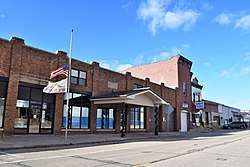Wenona, Illinois
Wenona is a city in Marshall and LaSalle counties in the U.S. state of Illinois. The population was 1,056 at the 2010 census, down from 1,065 in 2000.
Wenona | |
|---|---|
City | |
 Downtown Wenona, including its municipal building | |
 Location of Wenona in Marshall County, Illinois. | |
.svg.png) Location of Illinois in the United States | |
| Coordinates: 41°3′11″N 89°3′12″W | |
| Country | United States |
| State | Illinois |
| Counties | Marshall, LaSalle |
| Townships | Evans, Osage |
| Area | |
| • Total | 0.74 sq mi (1.91 km2) |
| • Land | 0.74 sq mi (1.91 km2) |
| • Water | 0.00 sq mi (0.00 km2) |
| Elevation | 694 ft (212 m) |
| Population (2010) | |
| • Total | 1,056 |
| • Estimate (2019)[2] | 938 |
| • Density | 1,274.46/sq mi (492.27/km2) |
| Time zone | UTC-6 (CST) |
| • Summer (DST) | UTC-5 (CDT) |
| ZIP Code(s) | 61377 |
| Area code(s) | 815 |
| FIPS code | 17-79813 |
| Wikimedia Commons | Wenona, Illinois |
| Website | www |
The Marshall County portion of Wenona is part of the Peoria Metropolitan Statistical Area, while the small portion that lies in LaSalle County is part of the Ottawa Micropolitan Statistical Area.
History
The city derives its name from Wenonah, Hiawatha's mother in Longfellow's poem The Song of Hiawatha.[3]
Geography
Wenona is located at 41°3′11″N 89°3′12″W (41.053080, −89.053415).[4] Most of the city lies in Marshall County, although a small portion extends into southern LaSalle County. In the 2000 census, all of Wenona's 1,065 residents lived in Marshall County. According to the 2010 census, Wenona has a total area of 0.74 square miles (1.92 km2), all land.[5]
According to the 2010 census, the city has a total area of 0.74 square miles (1.9 km2), all land.[6]
Demographics
| Historical population | |||
|---|---|---|---|
| Census | Pop. | %± | |
| 1870 | 879 | — | |
| 1880 | 911 | 3.6% | |
| 1890 | 1,053 | 15.6% | |
| 1900 | 1,486 | 41.1% | |
| 1910 | 1,442 | −3.0% | |
| 1920 | 1,203 | −16.6% | |
| 1930 | 1,005 | −16.5% | |
| 1940 | 967 | −3.8% | |
| 1950 | 1,005 | 3.9% | |
| 1960 | 1,005 | 0.0% | |
| 1970 | 1,054 | 4.9% | |
| 1980 | 1,025 | −2.8% | |
| 1990 | 950 | −7.3% | |
| 2000 | 1,065 | 12.1% | |
| 2010 | 1,056 | −0.8% | |
| Est. 2019 | 938 | [2] | −11.2% |
| U.S. Decennial Census[7] | |||
As of the census[8] of 2000, there were 1,065 people, 453 households, and 278 families residing in the city. The population density was 1,583.9 people per square mile (613.7/km2). There were 504 housing units at an average density of 749.6 per square mile (290.4/km2). The racial makeup of the city was 97.65% White, 0.38% Black or African American, 0.47% Native American, 0.19% Asian, and 1.31% from two or more races. 1.50% of the population were Hispanic or Latino of any race.
There were 453 households out of which 26.7% had children under the age of 18 living with them, 52.1% were married couples living together, 6.8% had a female householder with no husband present, and 38.6% were non-families. 34.9% of all households were made up of individuals and 18.1% had someone living alone who was 65 years of age or older. The average household size was 2.35 and the average family size was 3.10.
In the city, the population was spread out with 25.9% under the age of 18, 6.9% from 18 to 24, 25.4% from 25 to 44, 22.0% from 45 to 64, and 19.9% who were 65 years of age or older. The median age was 40 years. For every 100 females, there were 91.5 males. For every 100 females age 18 and over, there were 88.8 males.
The median income for a household in the city was $36,711, and the median income for a family was $45,714. Males had a median income of $32,237 versus $20,647 for females. The per capita income for the city was $17,951. About 4.2% of families and 7.8% of the population were below the poverty line, including 7.9% of those under age 18 and 11.2% of those age 65 or over.
References
- "2019 U.S. Gazetteer Files". United States Census Bureau. Retrieved July 14, 2020.
- "Population and Housing Unit Estimates". United States Census Bureau. May 24, 2020. Retrieved May 27, 2020.
- Illinois Central Magazine. Illinois Central Railroad Company. 1922. p. 43.
- "US Gazetteer files: 2010, 2000, and 1990". United States Census Bureau. 2011-02-12. Retrieved 2011-04-23.
- "G001 – Geographic Identifiers – 2010 Census Summary File 1". United States Census Bureau. Archived from the original on 2020-02-13. Retrieved 2015-12-27.
- "2010 Census U.S. Gazetteer Files for Places – Illinois". United States Census. Retrieved 2012-10-13.
- "Census of Population and Housing". Census.gov. Retrieved June 4, 2015.
- "U.S. Census website". United States Census Bureau. Retrieved 2008-01-31.
External links